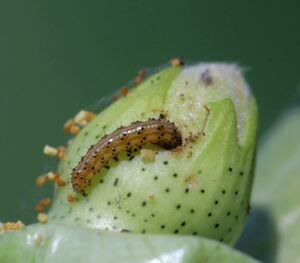Helicoverpa armigera densovirus 1
Classification
Higher order Taxa
Viruses (+ ssDNA virus); Shotokuvirae; Cossaviricota; Quintoviricetes; Piccovirales; Parvoviridae; Densovirus; Iteradensovirus
Species
|
NCBI: Helicoverpa armigera densovirus 1 Taxonomy [1] |
Helicoverpa armigera densovirus (genus), HaDNV1 (species)
Helicoverpa armigera densovirus (HaDNV-1) is a single stranded DNA virus that consists of the mutualism between the cotton bollworm (H. armigera) and a densovirus. A non-infected strain of H. armigera is a crop pest that feeds on agricultural resources, such as cotton, corn, rice, tomato, chickpea, etc. An infected strain of the cotton bollworm does the same, however at a greater effect. The densovirus directly increases the early growth rate of H. armigera and in effect, increases the overall fitness of the organism. In addition, densoviruses protect H. armigera from biopesticides like Bt toxin, which makes the cotton bollworm a more harmful organism to the environment as it can continue to feed on crops while being resistant to biological pesticides. This polyphagous, migratory species can be found in a number of areas, with its native home being Australia and Oceania, it can also be found in Brazil and the Caribbean. Since H. armigera depends on crops on survival, its habitat is based on largely horticultural areas where it can feed on more than 120 plant species in the appropriate climate.
Genome Structure
Helicoverpa armigera densovirus is a small icosahedral virus ranging from 4 to 6 kilobases. However, the size and organization of densovirus vary and given their structure, they can be classified into three different groups. The first group corresponds to densoviruses, like HaDNV-1 that have inverted terminal repeats on the DNA strand. Additionally, these viruses have an ambisense structure, meaning that both nonstructural (NS) and structural (VP) proteins are found on the starting 5' end of the DNA strand. On the other hand, viruses that belong to the Iteravirus or Brevidensovirus are monosense which suggests that the NS and VP proteins can be found at both the starting 5' end and the 3' end of the DNA strand.
Cell Structure, Metabolism and Life Cycle
Interesting features of cell structure; how it gains energy; what important molecules it produces.
Ecology and Pathogenesis

The Helicoverpa armigera densovirus HaDNV-1 (HaDNV-1) lives within its mutualist symbiont, the cotton bollworm moth (Helicoverpa armigera) larvae and pupa. H. armigera resides on the cotton plant and other crops throughout Asia, Africa, and Australasia. HaDNV-1 provides the moth larvae and pupa with an increased development rate, female longevity and fecundity, and protects the larvae from the baculovirus biopesticide, Helicoverpa armigera nucleopolyhedrovirus (HaNPV). HaDNV-1 possibly aids in H. armigera's tolerance of the baculovirus Cry1Ac toxin in bollworm strains that are susceptible to biopesticide. Cry1Ac is responsible for forming pores in the cell membrane by interacting with APN and ABC transporters on the cell membrane surface. The pores formed ultimately result in the death of the insect. Farmers are now trying to utilize new techniques to limit bollworm moth infestation of various plants due to this rising resistance to biopesticides through an unknown mechanism at this time. The newly discovered symbiosis of HaDNV-1 and H. armigera poses new threats to the cotton industry.
References
4. Ecosostenibile. (2021, June 30). (Italiano) helicoverpa armigera: Sistematica, habitat, Ciclo Biologico, lotta ... Un Mondo Ecosostenibile. Retrieved April 25, 2022, from https://antropocene.it/en/2021/06/30/helicoverpa-armigera/
5. ScienceDirect. (2016). Densovirus. Densovirus - an overview | ScienceDirect Topics. Retrieved April 25, 2022, from https://www.sciencedirect.com/topics/agricultural-and-biological-sciences/densovirus#:~:text=Densoviruses%20(DNVs)%20are%20small%20icosahedral,counterparts%2C%20in%20the%20family%20Parvoviridae
Author
Page authored by Abigael Frederick, David Duncan, and Bradley Enneking, students of Prof. Jay Lennon at Indiana University.

